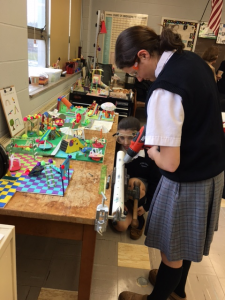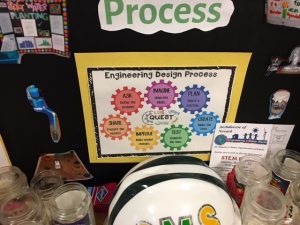The following article was contributed by Ann Kaiser, STEM Education Consultant, CEO of ProjectEngin LLC and Consultant with the Archdiocese of Newark.

At ProjectEngin, we firmly believe “E” is the key to unlocking the real potential of STEM, STEAM, or STREAM! Effective use of Engineering in the K-12 classroom can change your learning environment by providing a process and pathway that appeals to varied learners. Engineering truly is the “secret sauce” that can help you develop 21st century learning experiences.
Engineering Design is the process by which we use science and math to create technologies to solve human problems and to meet our needs. It creates engagement through challenges based on real-world issues, answering the age-old question “When am I going to use this?” It fosters enthusiasm for problem solving and creates empathy for the intended end-user. But, most importantly, Engineering empowers young people to focus on solutions not problems. E is the key to creating a STEM culture in your school and your classrooms!
At ProjectEngin, we work with teachers and students to leverage the power of E. We encourage teachers and students to tap into their inner engineer, exercising their imaginations, ingenuity, and critical thinking. A worthwhile Engineering Design challenge will create the engagement and enthusiasm needed to drive intrinsic motivation for learning. Students identify what they need to understand better in order to develop solutions. Our continual focus on empathy for the end-user as a hallmark of good design encourages students to go beyond classroom walls and their own experiences and needs. Most importantly, we focus on solutions not problems, on possibilities not limits, and on the common human experience.

We really enjoyed presenting at the NCEA National Convention in St. Louis and sharing with others how they can begin to maximize the E. We guided attendees through the key parts of the process we follow to develop classroom projects and practices. Instead of just discussing simple circuits, we encouraged them to challenge their students to change another child’s life by designing a simple device to provide light for reading without the crippling health and environmental effects of kerosene lamps. Instead of studying simple rate equations, apply that knowledge to create better assembly lines and improved working conditions for people in different parts of the world. Learn how to frame a challenge in a way that generates the enthusiasm and engagement that comes from applying knowledge in a meaningful way.
It is well known that young people have tremendous empathy and that the best designs are driven by end-user needs. We shared resources to help attendees bring another part of the world into their STEM classroom. They experienced firsthand the activities that we have developed to explore the appropriate use of technologies and the need for empathy and understanding of different cultures and lifestyles. Most importantly, they learned how to empower young people to engineer a better world for all.
Join us at the 2017 NCEA New Directions Exceptional Learners Conference and leave with activities, project ideas, and resources designed to help you maximize the E!